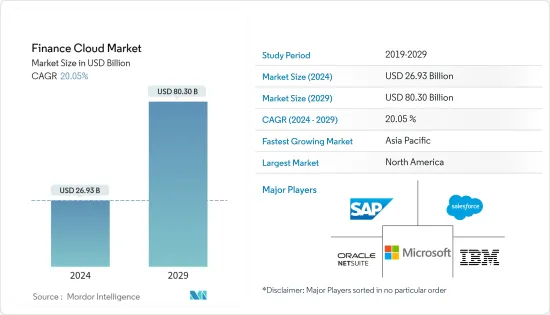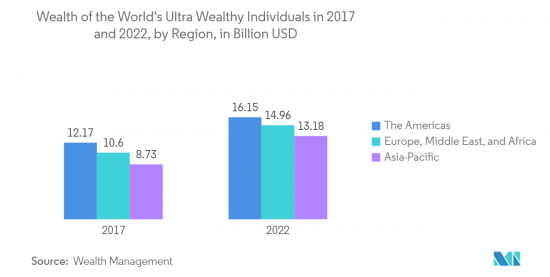 |
市场调查报告书
商品编码
1402969
金融云-市场占有率分析、产业趋势与统计、2024年至2029年的成长预测Finance Cloud - Market Share Analysis, Industry Trends & Statistics, Growth Forecasts 2024 - 2029 |
||||||
价格
※ 本网页内容可能与最新版本有所差异。详细情况请与我们联繫。
简介目录
金融云市场规模预计到 2024 年为 269.3 亿美元,预计到 2029 年将达到 803 亿美元,在预测期内(2024-2029 年)复合年增长率为 20.05%。

随着收益的增加,云端增加了产生的潜在客户数量并提供了更好的定价。
主要亮点
- 银行服务以及金融和保险公司正在选择数位应用程式来快速回应持续的客户询问、考虑长期利益并获得竞争优势。例如,Ess Kay Fincorp 选择云端基础的贷款平台来数位化其整个贷款业务,并将贷款核准时间减少 33%。
- 提高业务效率也是推动金融云市场成长的因素之一。 Roha Housing Finance 希望在两小时内发放贷款,而不是传统的三天。透过利用云端基础的技术的敏捷性和成本效率来提供「客户至上」的方法,该公司可以在 7 天内处理端到端贷款,比现有的住宅行业基准快 50%。
- 在印度、中国、巴西、非洲等新兴国家地区,金融云端处理服务市场拓展空间庞大。例如,监控和分析软体供应商 ITRS Group Ltd. 预测,今年亚太地区 86% 的金融服务业将使用公有云。透过利用云端基础的应用程序,企业可以大幅降低采购、维护和升级 IT 系统和设备的成本。
- 然而,资料安全和保护问题、高昂的投资和维护成本正在限制金融云端产业的扩张。资料遗失通常会损害云端储存的安全性。资讯可能会因电脑病毒、骇客攻击和系统故障而完全受到损害,而不是被窃取或共用。
- COVID-19的疫情对金融云市场产生了正面影响。随着全球 COVID-19 病例激增,经济放缓。然而,儘管发生了大流行,银行、保险和金融服务业仍继续运作。疫情期间,金融机构被迫迅速采用远距办公,促使对云端基础的基础设施的投资。德意志银行和 Google Cloud 在 COVID-19 期间签署了为期 10 年的策略云端合作伙伴协议。此次合作预计将提高弹性、快速创造新技能并降低成本。
金融云市场趋势
财富管理产业主导市场
- 随着世界财富的增加,财富管理专业人士的数量也不断增加。瑞士信贷今年的财富报告显示,去年财富成长强劲,截至年终,以目前外汇计算,全球财富总合463.6兆美元,成长9.8%。
- 事实上,根据加拿大皇家银行财富管理公司 (RBC Wealth Management) 的数据,去年这些人最集中的地区是北美,那里有 790 万富裕人士。去年亚太地区的富裕人士人数为 720 万人。拥有100万美元或以上资产的个人是净资产最高的个人。
- 报告称,未来五年全球财富预计将成长约26%,明年将达到399兆美元。中阶的成长将成为财富的关键驱动力,未来五年亿万富翁的数量将激增,达到 5,500 万的历史新高。
- 事实上,富裕人士的需求很大。他们的业务竞争比以往任何时候都更加激烈。因此,公司必须利用金融云等最尖端科技继续创新并在不断增长的市场中占据更大份额。
- 人工智慧的日益普及是市场的新趋势之一。财富管理是金融服务业中最早大量利用人工智慧技术的领域之一。 AI运算会产生庞大的金融资料集,因此AI应用需要使用云端网路。因此,由于人工智慧在金融领域的使用不断增加,金融云市场也有望在研究期间出现。

亚太地区将经历最高的成长
- 亚太地区的金融机构正在进行数位转型。这使得金融机构能够提高成本效率。例如,在印度,印度政府正在透过金融科技等措施致力于付款系统数位化并扩大金融包容性,即 Jan Dhan Yojana、Aadhaar 和 UPI 统一支付介面。
- 去年四月,中国央行宣布将加速中国金融科技基础设施的发展,以适应日益受到资料、人工智慧和大科技影响的金融业。这包括更新连接所有央行分店的资料中心和网络,以及去年建立「央行云端」。
- 由于 BFSI 行业不断变化,印度的小型金融银行 (SFB) 已处于发展的早期阶段。这些金融机构希望制定可行的产业计画,以满足社会弱势群体的需求。许多现代银行正在采用云端和人工智慧/机器学习来快速评估风险,并为客户做出更快、更资讯的决策。
- 在公共部门倡议、中小企业以及银行、金融服务和保险 (BFSI) 行业数位创新的帮助下,科技巨头 Oracle 公司在印度 (SME) 的云端业务方面取得了重大进展。借助Oracle云,银行可以减少对资料中心基础设施的依赖、仅按使用量付费以及将容量与业务需求相匹配,从而实现价值最大化。据 Oracle 称,与使用其他云端供应商的银行相比,使用其云端的银行可降低高达 50% 的成本。
金融云业概况
金融云市场竞争激烈,由几个主要企业组成。为了巩固市场地位,参与企业正在采取产品创新、联盟和併购等策略。
- 2023 年 2 月 - 软体投资公司 Thoma Bravo 宣布完成 Coupa Software 约 80 亿美元的收购,Coupa Software 提供云端基础的业务支出管理平台,整合了跨供应链、采购和财务职能的流程。
- 2022 年 1 月 - 软体即服务 (SaaS) 和业务流程即服务 (BPaaS) 供应商 Avaloq 继续加强与加拿大皇家银行旗下 RBC 财富管理公司在亚洲的长期合作伙伴关係。我们还将协助 RBC Wealth Management 推进其云端基础的SaaS 模式,并透过引入更复杂的解决方案来实现其财富管理平台的现代化。
其他福利
- Excel 格式的市场预测 (ME) 表
- 3 个月的分析师支持
目录
第一章简介
- 研究假设和市场定义
- 调查范围
第二章调查方法
第三章执行摘要
第四章市场洞察
- 市场概况
- 产业吸引力-波特五力分析
- 新进入者的威胁
- 买家/消费者的议价能力
- 供应商的议价能力
- 替代品的威胁
- 竞争公司之间的敌对关係
第五章市场动态
- 市场驱动因素与市场抑制因素简介
- 市场驱动因素
- 客户关係管理改善需求
- 金融业业务效率需求
- 市场抑制因素
- 云端基础的网路威胁的兴起
第六章市场区隔
- 按解决方案/服务
- 财务预测
- 财务报告与分析
- 风险与合规性
- 管理服务
- 按发展
- 公共云端
- 私有云端
- 按地区
- 北美洲
- 欧洲
- 亚太地区
- 拉丁美洲
- 中东/非洲
第七章竞争形势
- 公司简介
- Oracle 公司(和 Netsuite)
- IBM Corporation
- Microsoft Corporation
- Salesforce.com Inc.
- SAP SE
- Sage Intacct Inc.
- Workday, Inc.
- Unit4(and FinancialForce)
- Acumatica Inc.
- Huawei Technologies Co. Ltd
第八章投资分析
第九章 市场机会及未来趋势
简介目录
Product Code: 46324

The Finance Cloud Market size is estimated at USD 26.93 billion in 2024, and is expected to reach USD 80.30 billion by 2029, growing at a CAGR of 20.05% during the forecast period (2024-2029).
Along with increased revenue, the cloud increases the number of leads generated and offers better pricing.
Key Highlights
- Banking services and financial and insurance companies are opting for digital applications to quickly address customers' ongoing queries, along with keeping into consideration the long-term benefits and achieving a competitive advantage. For instance, Ess Kay Fincorp chose a cloud-based lending platform to digitize its entire lending business and decrease its loan approval time by 33%.
- Operational efficiency is another factor driving the growth of the finance cloud market. Roha Housing Finance wanted to issue loans within two hours instead of three days. After adopting the agility and cost efficiency of cloud-based technology to offer a "customer-first" approach, it was able to provide end-to-end loan processing in seven days, which is 50% faster than the benchmark for the housing finance industry.
- In developing nations and areas like India, China, Brazil, and Africa, the market for financial cloud computing services has a lot of room to expand. For instance, the ITRS Group Ltd., a monitoring and analytics software provider, predicted that 86% of the Asia Pacific financial services industry would use the public cloud this year. By utilizing cloud-based applications, businesses can significantly reduce the cost of purchasing, maintaining, and upgrading IT systems and equipment.
- However, problems with data security and protection and expensive investment and maintenance expenses limit the expansion of the finance cloud industry. Data loss routinely puts cloud storage's security in jeopardy. Information can be affected entirely by a computer virus, hacking, or a broken system instead of being stolen and shared.
- The COVID-19 epidemic had a favorablly impacted on the financial cloud market. Due to an upsurge of COVID-19 cases worldwide, the economy slowed down. However, the banking, insurance, and financial services industries continued to function despite the pandemic. During the epidemic, financial institutions were forced to rapidly adopt remote working, which prompted investment in a cloud-based infrastructure. Deutsche Bank and Google Cloud signed a 10-year strategic cloud collaboration agreement during COVID-19. The alliance is anticipated to boost resilience, quicken the creation of new skills, and cut costs.
Finance Cloud Market Trends
Wealth Management sector to Dominate the Market
- As global wealth increases, there is a rise in wealth management professionals. As per the Credit Suisse Wealth Report of the current year, wealth grew at a strong pace last year, and by year's end, global wealth at prevailing exchange rates totaled USD 463.6 trillion, a gain of 9.8%.
- In fact, according to RBC Wealth Management, North America accounted for the most significant concentration of these people last year with 7.9 million HNWIs living there. The number of HNWIs reported in the Asia Pacific region was 7.2 million last year. The individuals with a fortune of over USD 1 million are the highest Networth Individuals.
- The same report indicates that global wealth is projected to increase by about 26% over the next five years, reaching USD 399 trillion by the following year. Growth in the middle class will be the main driver of wealth, but over the next five years, there will be a sharp rise in the number of millionaires, who will reach a new all-time high of 55 million.
- In fact, there's a lot of demand for wealthy individuals with HNWIs. And the competition is even more fiercethan ever in terms of their business. Consequently, businesses must continue to innovate and gain a bigger share for the growing market by staying on top of cutting edge technologies such as Finance Cloud.
- The growing use of AI is one of the market's emerging trends. Wealth management is one of the first sectors in the financial services sector to utilize AI-based technology in a substantial way. The production of huge financial datasets by AI computation makes the use of cloud networks necessary for AI applications. As a result, the Financial Cloud Market will also emerge over the research period as a result of the growing use of AI in the finance sector.

Asia-Pacific to Witness the Highest Growth
- Financial institutions across the Asia-Pacific region are embracing digital transformations. This allows them to be more cost-efficient. For instance, in India, through fintech initiatives like the The Indian Government is working towards digitisation of payment systems and increasing financial inclusion, i.e. Jan Dhan Yojana, Aadhaar & UPI Unified Payments Interface.
- In April last year, in an effort to keep up with a financial sector that is increasingly being shaped by data, artificial intelligence, and Big Tech, China's central bank announced that it was accelerating infrastructure development for its own financial technology. This includes updating its data centers and the network connecting all central bank offices and branches, as well as establishing a "central bank cloud" last year.
- Small Finance Banks (SFBs) in India have reached a nascent stage of evolution due to the constantly changing BFSI sector. These financial institutions want to create a workable business plan that will meet the demands of the underprivileged groups in society. Many of these modern banks employ the cloud and AI/ML to make quicker and more informed decisions for their customers, along with quick risk assessments.
- With the help of public sector initiatives, small and medium-sized businesses, and digital innovation in the banking, financial services, and insurance (BFSI) industries, technology giant Oracle Corp. is experiencing substantial development in its cloud business in India (SMBs). Banks can lessen their dependency on data center infrastructure, pay only for what they use, and maximize value by aligning capacity with business demand with Oracle Cloud. Oracle says that banks that use their cloud can cut costs by up to 50% compared to banks that use other cloud providers.
Finance Cloud Industry Overview
The Finance Cloud market is competitive and consists of several major players. In order to gain a better foothold in the market, players are adopting strategies such as product innovation, partnerships and mergers and acquisitions
- February 2023 - Thoma Bravo, a software investment firm, announced that it had completed its acquisition of Coupa Software, a provider of cloud based business spend management platform that unifies processes across the supply chain, procurement, and finance functions, for approximately $8.0 billion.
- January 2022 - Avaloq, a provider of software as a service (SaaS) and business process as a service (BPaaS) and ), In Asia, they will continue to strengthen their longstanding partnership with RBC Wealth Management, an operation of the Royal Bank of Canada. It will also help RBC Wealth Management to move forward with a cloud based SaaS model and modernise the wealth management platform by implementing more sophisticated solutions.
Additional Benefits:
- The market estimate (ME) sheet in Excel format
- 3 months of analyst support
TABLE OF CONTENTS
1 INTRODUCTION
- 1.1 Study Assumptions and Market Definition
- 1.2 Scope of the Study
2 RESEARCH METHODOLOGY
3 EXECUTIVE SUMMARY
4 MARKET INSIGHTS
- 4.1 Market Overview
- 4.2 Industry Attractiveness - Porter's Five Forces Analysis
- 4.2.1 Threat of New Entrants
- 4.2.2 Bargaining Power of Buyers/Consumers
- 4.2.3 Bargaining Power of Suppliers
- 4.2.4 Threat of Substitute Products
- 4.2.5 Intensity of Competitive Rivalry
5 MARKET DYNAMICS
- 5.1 Introduction to Market Drivers and Restraints
- 5.2 Market Drivers
- 5.2.1 Need for Improved Customer Relationship Management
- 5.2.2 Demand for Operational Efficiency in Financial Sector
- 5.3 Market Restraints
- 5.3.1 Rise of Cloud-based Cyber Threats
6 MARKET SEGMENTATION
- 6.1 By Solution and Service
- 6.1.1 Financial Forecasting
- 6.1.2 Financial Reporting and Analysis
- 6.1.3 Risk and Compliance
- 6.1.4 Managed Service
- 6.2 By Deployment
- 6.2.1 Public Cloud
- 6.2.2 Private Cloud
- 6.3 By Geography
- 6.3.1 North America
- 6.3.2 Europe
- 6.3.3 Asia Pacific
- 6.3.4 Latin America
- 6.3.5 Middle East & Africa
7 COMPETITIVE LANDSCAPE
- 7.1 Company Profiles
- 7.1.1 Oracle Corporation(and Netsuite)
- 7.1.2 IBM Corporation
- 7.1.3 Microsoft Corporation
- 7.1.4 Salesforce.com Inc.
- 7.1.5 SAP SE
- 7.1.6 Sage Intacct Inc.
- 7.1.7 Workday, Inc.
- 7.1.8 Unit4(and FinancialForce)
- 7.1.9 Acumatica Inc.
- 7.1.10 Huawei Technologies Co. Ltd
8 INVESTMENT ANALYSIS
9 MARKET OPPORTUNITIES AND FUTURE TRENDS
02-2729-4219
+886-2-2729-4219













